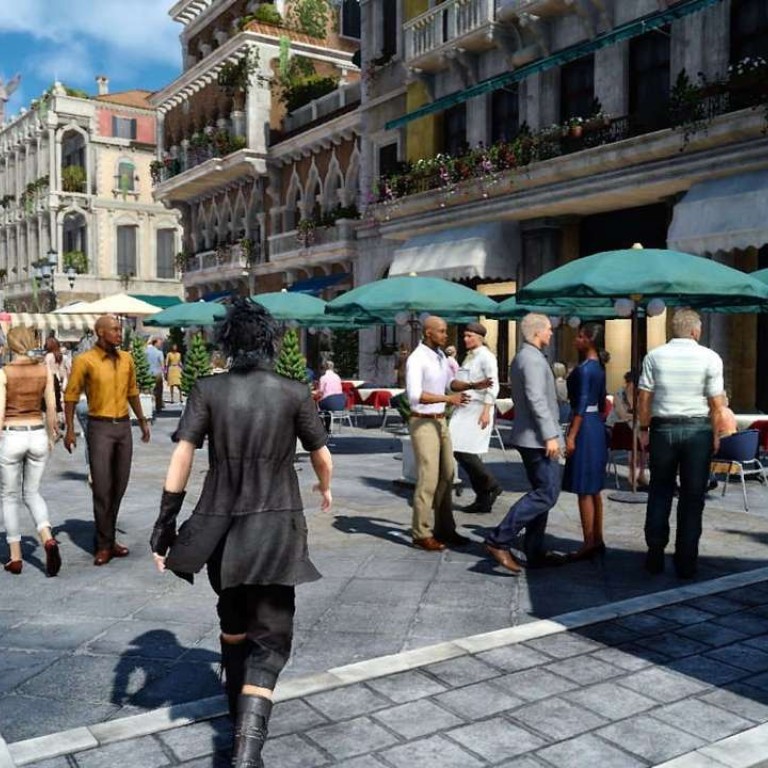
Final Fantasy XV – all the poetry and frustration of a road trip
Final Fantasy XV is at its best when treated as a journey, but it’s intrusive when it tries to keep you busy and comforting when it settles for just keeping you company
Final Fantasy XV
Square Enix
3/5 stars
It’s hard to see how you can go from Final Fantasy, an eight-bit interpretation of Dungeons and Dragons from a small group of Japanese developers released in 1987, to Final Fantasy XV, a rambling road trip that mashes together so many different points of reference and kinds of play – fishing, driving, monster combat, farming, ranching, photography – that no one component could be said to be definitive.
It’s a game that seems to have anticipated its own player’s boredom and tried to forestall it with a web of potential alternatives. This is the logic of many video game sequels: over time, they become more about the nostalgia for previous games in the series.
Final Fantasy XV (for the PlayStation 4 and Xbox One) begins when a post-pubescent prince called Noctis is sent off with three friends on a road trip to a neighbouring kingdom for Noctis’ arranged marriage, which was organised in order to defend against a third kingdom that’s edging closer to war. “I ask not that you guide my wayward son,” the King tells Noctis’ companions upon departing, “merely that you remain at his side.”
What follows is a long procession of familiar iconography from the Final Fantasy series buried like dinosaur bones waiting to be discovered. For example, convenience stores spread throughout the game world sell soundtracks from earlier Final Fantasy games to play on the car’s audio system as you drive, and Prompto, the most boyish of Noctis’ three comrades, will occasionally hum the victory fanfare from older games after a fight.
These callbacks fit neatly into the game’s structure as a travel narrative that unfolds largely from idle time spent in the back seat of a car. The first half of the game has a meandering pace: Noctis and his entourage will crisscross the land collecting car parts, retrieving precious stones for a sleazy collector, killing monsters at the behest of diner cooks, taking photographs at out-of-the-way locales for a magazine editor, and salvaging dog tags from fallen mercenaries.

Though they appear varied, in practice these quests are all, essentially, travelling from point to point, approaching a small glowing orb to collect an item and then carrying it back to the person who sent you. During missions that advance the main story, this formula is altered only by the number of glowing orbs or monster clusters to visit before being given a baroque and inscrutable monologue from someone dressed in an ornamental cowl and motorcycle boots.
The game captures the helpless tranquillity of being a passenger in a car, with long limbo-like stretches between destinations where there’s little to do but swivel the camera, look at the scenery and listen to music. The landscape seems to have been made to be viewed from the car – the changes in terrain from sandy plains to grassy hillsides are subtler than the wild shifts in earlier games. On foot, one moves through these huge open spaces at a hopelessly slow pace, but from a car there’s just enough detail to produce a slow sense of transition that keeps one’s senses focused and vaguely curious.
The default option is to have a friend, Ignis, drive everywhere, but even when you choose to manually drive there’s a sense of automation. The car steers itself on long, winding roads and there’s little to do beyond hold the accelerator down and select where to stop. Though it initially feels bizarre to have so little control for such long periods of time, over time it becomes a beautiful evocation of car travel and the long, yawning moments with nothing to do but wait.
Much of the action between these meditative stretches is strangulated in regional stereotypes and objectification, both sexual and national. Cindy, one of the support characters who works on the group’s car and supplies side quests, speaks in an exaggerated Southern accent and spends the whole game in a bikini top and what might as well be denim underpants.

Altissia, a city Noctis visits halfway through the game, is a theme park version of a European city with canals and sidewalk cafes backed by French accordion music. Another city has an officially sponsored Nissin Cup Noodle truck selling instant ramen to restore health points, while the various camp sites at which you can take shelter when the sun goes down show Noctis and friends using Coleman-branded folding chairs, coolers and tents.
There’s a crassness to these elements. They feel as out of place as a marching band in a bedroom at sunrise. This dislocating surreality has always been a part of what distinguished the Japanese role-playing game from other role-playing games. “Yoshoku” is the term used to describe the absorption of American and European dishes into Japanese cuisine. Bunless hamburgers served with ketchup demi-glace and stir-fried spaghetti would be alien to most American palates, but they exist in an intermediary zone where the mutual fixation of two cultures has produced a third neither could claim as its own.
Final Fantasy XV is at its best when treated as an act of tourism. It’s gratingly intrusive when it tries to keep you busy, and transcendentally comforting when it settles for just keeping you company.

